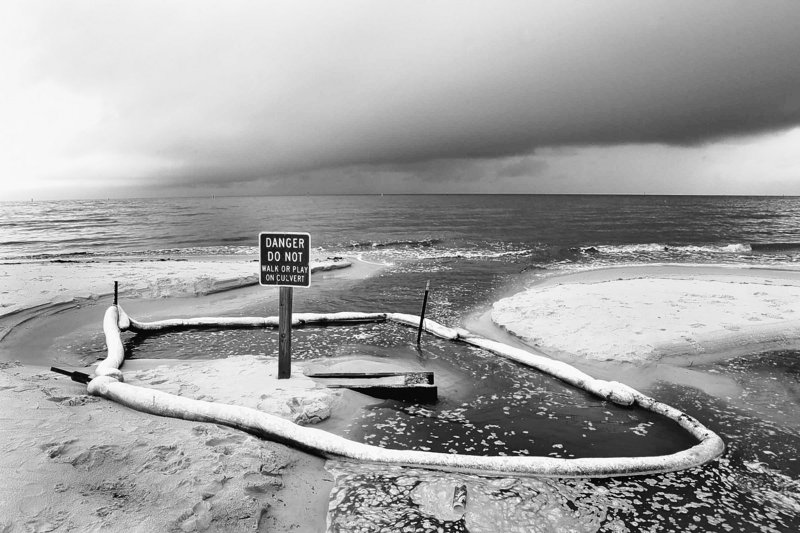MIAMI – With oil giant BP’s runaway well Thursday becoming the biggest spill ever in the Gulf of Mexico, according to government estimates, rough seas and winds from Tropical Storm Alex continued to ground skimming and booming operations from the Mississippi Delta to Florida’s Panhandle, U.S. Coast Guard officials said.
Meanwhile, a top BP executive called the Deepwater Horizon spill “a game changing event” for the oil and gas industry that likely will lead to stricter safety standards, and he vowed that the company will fulfill its promise to make the Gulf whole again.T
he armada of ships skimming oil, laying boom, conducting controlled burns and transporting equipment likely will remain idle through today, said U.S. Coast Guard Cmdr. Charles Diorio.
“Operations have been severely impacted by weather in the Gulf,” Diorio said Thursday. “The weather today unfortunately looks much the same as yesterday.”
Diorio said skimming, a vital part of the Coast Guard’s response strategy, would not resume until waves fell below 4 feet — possibly not until Saturday, according to forecasts.
As thousands of ships sit idle, response crews awaited the launch of the “whale,” a Taiwanese supertanker retrofitted as a giant skimmer — measuring the length of three football fields and capable of vacuuming 21 million gallons of oily water a day.
“That vessel is currently in New Orleans,” Diorio said, “and it’s being inspected by a team of personnel, both Coast Guard and BP and other agencies trying to figure out the best way to employ it, if we can employ it at all. Hopefully, that will be decided within the next day or so.”
Other resources poised to join the response effort are U.S. Navy and private aircraft, including a blimp, which will survey the region from above and direct ships to the moving oil slick.
In a webcast interview with PBS’ “NewsHour” on Thursday, Bob Dudley, president and chief executive of BP’s Gulf Coast Restoration Organization, said the company was establishing an air center at Tyndall Air Force Base near Panama City to conduct surveillance flights.
Expressing confidence that BP would not be driven to bankruptcy by claims for damages and potential government fines, Dudley said the oil giant also is determined to seal the leaking well and make the Gulf whole again.
“We will find a way to shut this well off,” he said, “and then we will continue to devote all the resources necessary to clean up the Gulf and restore it to the way it was, and it will take years.”
Dudley pointed to BP’s agreement to create a $20 billion fund over four years as evidence of the company’s intention to clean the spill and compensate victims.
“It signals BP’s long-term commitment,” he said.
While expressing regret for the disaster, Dudley stopped short of accepting full responsibility.
He said a forensic examination was required of the events leading up to the Deepwater Horizon’s explosion, and expressed confidence that “facts are going to emerge” showing the disaster was the result of both errors of judgment and failure of equipment, such as the blowout preventer.
A joint investigation by the Coast Guard and the Department of the Interior into the Deepwater Horizon disaster is under way. A final report has yet to be issued.
While Tropical Storm Alex dissipated over Mexico and grounded response efforts along the coasts, it did not cause a suspension of long-term operations at the site of the Deepwater Horizon well head, about 130 miles southeast of New Orleans, where large drilling and production ships are capturing oil from the ruptured pipe, and drilling relief wells that offer the best chance to seal the undersea gusher.
The storm has delayed, however, the launch of a new system that could double the amount of oil captured daily from the ruptured well to about 53,000 barrels a day.
Current projections estimate that the broken well is gushing 35,000 barrels (or 1.4 million gallons) to 60,000 barrels (or 2.7 million gallons) per day.
Since the April 20 explosion that sank the Deepwater Horizon drilling rig, killing 11 workers and setting off the spill, an estimated 140.6 million gallons of oil had spewed into the Gulf as of Thursday.
In 1979, Mexico’s Ixtoc 1 offshore well in the Gulf of Campeche leaked an estimated 140 million gallons.
Government officials are keeping track of the amount of oil spilled by the Deepwater Horizon well because it will inform decisions ranging from fines, if any, imposed against BP; to the environmental cleanup that will be required.
Diorio said the massive spill response would continue until the undersea gusher is sealed, possibly some time in August if relief wells prove successful.
Meanwhile, cleanup efforts got a boost late Tuesday, when the U.S. State Department announced that it had accepted 22 offers of assistance from 12 countries, including two high-speed skimmers and fire-containment boom from Japan.
Details of the offers, most of which require reimbursement, were still being worked out Thursday, including the method of delivery and timetable for their arrival.
In the meantime, BP has been working to launch a new oil collection system, which consists of a flexible pipe attached to a containment dome that will be lowered over the broken well and siphon oil to a waiting ship, the Helix Producer.
BP’s Dudley said he expects the new system will be operational by July 8.
To date, oil from the spill has affected about 413 miles of Gulf Coast shoreline, including about 259 miles in Louisiana, 48 miles in Mississippi, 47 miles in Alabama and 59 miles in Florida, according to federal estimates.
In addition, about 80,000 square miles of Gulf waters have been closed to fishing, leaving about 66 percent of federal waters open.
Send questions/comments to the editors.



Comments are no longer available on this story